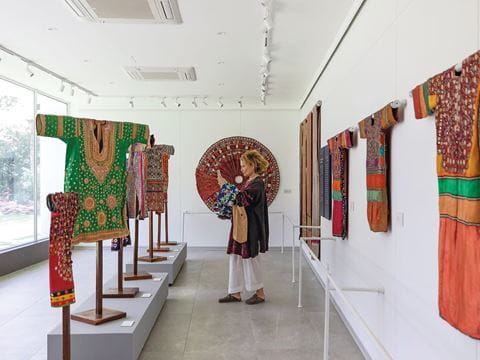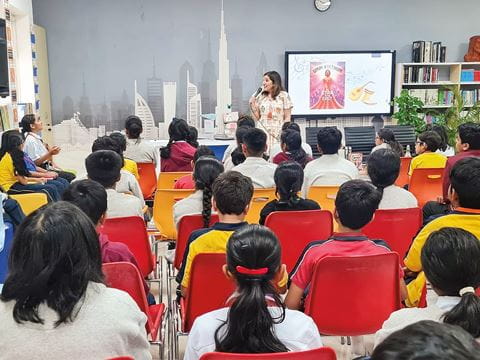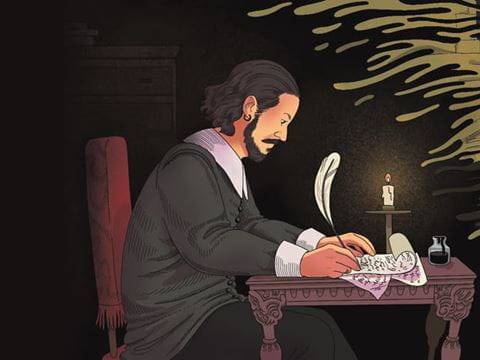
Meet Sculptor Marie Khouri, Who Turns Arabic Calligraphy Into 3D Art
Vancouver-based artist Marie Khouri turns Arabic calligraphy into a 3D examination of love in Baheb, on view at the Arab World Institute in Paris.
At first glance it looks as if parts of a dinosaur skeleton have been laid out on the floor. Except this is a gallery, not a natural history museum. And the smooth white objects—which resemble alien figures, either reclining or curling up—are made of fiberglass, not bone.
Viewed from above, the perspective shifts. The enigmatic objects are huge, sculpted letters of the Arabic alphabet, which spell out in fluid calligraphy the word baheb: “I love.”
This imposing installation is the work of Marie Khouri, a Vancouver-based sculptor. Born in Egypt and raised in Lebanon, she also lived in France for 30 years. Her work explores language and connection, fusing form and meaning in sinuous sculptures that ask to be touched.
Baheb is currently on view at the Arab World Institute in Paris, as part of a calligraphy exhibition this year.

Marie Khouri uses traditional sculpting techniques and contemporary innovations such as 3D printing.
“A distinctive feature of the Arabic alphabet is that a letter will take on different shapes depending on whether it is at the beginning, the middle or the end of a word,” said Éric Delpont, one of the curators of the exhibition. “This opens up a range of artistic possibilities not available with the Latin alphabet, which is used by English and most European languages.”
The exhibition explores the richness and diversity of Arabic calligraphy as a visual and cultural marker that unites the Arab and Muslim worlds. It aims to create a dialogue between the past and the present by displaying ancient pages of the Qur’an alongside vibrant, geometric calligraphy from the 20th century and photographs of contemporary street art.
AramcoWorld spoke to Khouri about her creative process and artistic influences.

Khouri’s work comes full circle in the country of her birth with a heartfelt message in "I Love," part of Art D’Égypte’s fourth edition Forever Is Now exhibition at the Pyramids of Giza in 2024.
AramcoWorld: When did you decide that you wanted to become a sculptor?
Marie Khouri: I don’t have any artists in my family, so there was nothing to tell me that one day I would go down that route.
I already had children by the time I decided to try my hand at art. I began with a drawing class because it seemed the easiest option, requiring only pencil and paper.
But it was the most frustrating experience of my life because I was unable to transpose onto paper what I was visualizing in my head.
So I switched to sculpting, and I never looked back. I took more and more classes at the École du Louvre.
I think sculpture opened a Pandora’s box for me. Through the forms I was creating, I was able to speak about my inner life, about things that had been buried for a long time.
AramcoWorld: You originally worked as an interpreter. How did this involvement with the Arabic language feed into your work as a sculptor?
Marie Khouri: I spoke four languages when I lived in the Middle East and Europe: Arabic, French, Spanish and Italian. It wasn’t until I emigrated to Canada as a teenager that I learned English.
In a way, sculpting brought me full circle.
As I worked the clay in my hands, I realized that the shapes I was forming were very much like the curves you find in Arabic calligraphy. It was happening almost subconsciously—these curves were almost directing my hands.
So clay became another language for me: a new way to communicate, through art.
AramcoWorld: How do you go about creating sculptures on a public art scale?
Marie Khouri: I’ve been doing public art now for 20 years, and I have over 30 pieces of public art worldwide.
My process is always the same. I make small clay models by hand. Then I photograph the models and superimpose a scaled-up image onto a photograph of wherever the sculpture is going, to give an idea of how the piece will look in place.
We scan the models and 3D-print them, scaled up, in expanded polystyrene. I then recarve these forms because you inevitably lose some of the definition in the upscaling process. This takes time, but it’s faster than if I were sculpting from a block.
Once I have finished recarving, we lay fiberglass over the forms and then apply a hard coating on top. Finally, we spray the sculptures with a special white paint to give a matte finish, which looks and feels like talcum powder. This is all done by hand, so it’s labor intensive.
I have made some sculptures in stone for private collectors. It’s a similar process: I make a model, I print an intermediate size in polystyrene, then the stone is hand-carved in Italy.
I am closely involved throughout. They send me detailed photographs and ask specific questions. Do I want a certain angle to be sharp or rounded? Should they start at the top or the bottom? There is constant communication, and I travel there several times during the process.

Left: Working in diverse mediums, from bronze to charcoal, expanded polystyrene to wood, Khouri forms sculptures that reflect her multicultural experiences and connection to languages. Right: Made of concrete and standing 3.6 meters (12 feet) tall in Burnaby, Canada, Khouri's "Vantage" has become part of the city landscape. (Ema Peter)
This tactile connection to the work is important to me. I wanted to get away from the old style of museum where you can look but not touch.
AramcoWorld: As you are sculpting Arabic letters in clay, how do particular words or phrases come into your mind?
Marie Khouri: It is a conscious choice. In 2014 I sculpted a sentence that read, “Let’s sit and talk.” I wanted to send a message that dialogue was the way to resolve differences.
The sculpture brought together form and meaning: Not only was it a readable sentence but also a series of benches that you could sit on. And they were white, a bit like waving a white flag. So all of these things had a meaning.
Today this sculpture has taken on a new significance, given the way that technology is changing our lives. Whether you’re in a bus, a train or a plane, everyone is just looking at screens. We don't have time anymore to sit down and talk to each other in a human way.
I have now sculpted models of the whole Arabic alphabet [that] we have scanned into our system. So I can choose different sentences to create bodies of work, fusing language and sight and touch.
This tactile connection to the work is very important to me. I wanted to get away from the old style of museum where you can look but not touch. I wanted to democratize the experience. My sculptures are made of fiberglass, so they're strong and sturdy, which allows this interaction to happen.
AramcoWorld: Who are your artistic influences?
Marie Khouri: The French sculptor Auguste Rodin has been a big influence. His process involved making little models—of hands, feet and heads—and reusing these same elements in different works.
As someone who works with my hands, I love the way Rodin treated hands and other parts of the body. I really relate to his practice.
The British sculptor Henry Moore has also been a source of inspiration. I seem to share something of his ability to make a small model, place it on the grass and visualize it as several meters tall.
AramcoWorld: How did you get the idea for baheb?
Marie Khouri: I wanted to sculpt a phrase that has universal resonance.
“I love” is meant to carry weight. …
It has become light and fluffy. I wanted to give it a substance again.
Baheb was first exhibited in Vancouver. Then it was included in an open-air exhibition at Giza, with the pyramids as a backdrop.
This was a beautiful experience because I was born in Cairo, and to bring a body of work like that to Egypt was so meaningful to me.
Baheb began as a concept, but it has gone beyond that. My intention is for the work to travel through museums worldwide, spreading a message of hope and love.

Acting both as art and functional seating, "Let's Sit and Talk" is designed to bring people together. The piece is made of expanded polystyrene with a polyurea hard coat. (Ema Peter)
The Arab World Institute is running a series of calligraphy workshops to coincide with the exhibition. The aim is to demonstrate that calligraphy is a practical skill as well as an art form.
“Each person’s handwriting is as unique as their fingerprints,” said Delpont, the curator. “Whereas the computer keyboard erases this diversity.”
The importance of preserving calligraphy as a living craft is illustrated in the closing displays—photographs of huge murals by the French street artist Yann Chatelin, also known as Poze.
His work explores the tension between the individuality of handwriting and the uniformity of printed text. Human figures appear to dissolve while Arabic letters fly away.
A powerful evocation of the beauty of calligraphy—and a reminder that human expression would be poorer without it.
“Writing or calligraphy? The Sublimated Arabic alphabet” exhibition is taking place at the Arab World Institute in Paris through September 25, 2025.
You may also be interested in...

Nasreen ki Haveli: Pakistani Textile Museum Fulfills a Dream
Arts
Collector Nasreen Askari and her husband, Hasan, have turned their home into Pakistan’s first textile museum.
Meet the Author Who Invites Children To Discover ‘Star of the East’
Arts
Culture
In Umm Kulthum: The Star of the East, Syrian American author and journalist Rhonda Roumani illuminates the life of a girl from the Nile Delta who rose to become one of the most celebrated voices in the Arab world.
Stratford to Jordan: Shakespeare’s Echoes of the Arab World
Arts
History
Shakespeare’s works are woven into the cultural fabric of the Arab world, but so, too, were his plays shaped in part by Islamic storytelling traditions and political realities of his day.